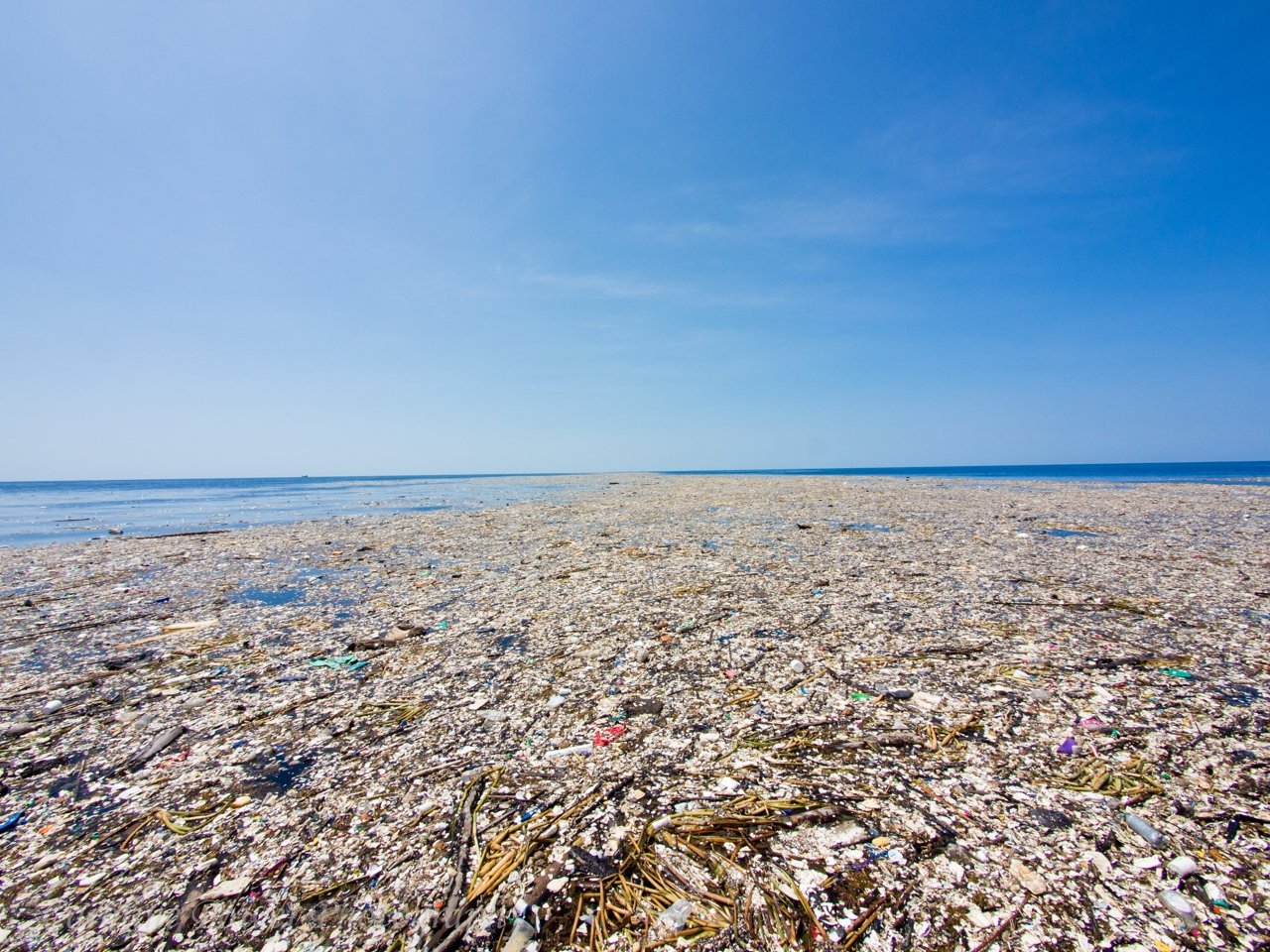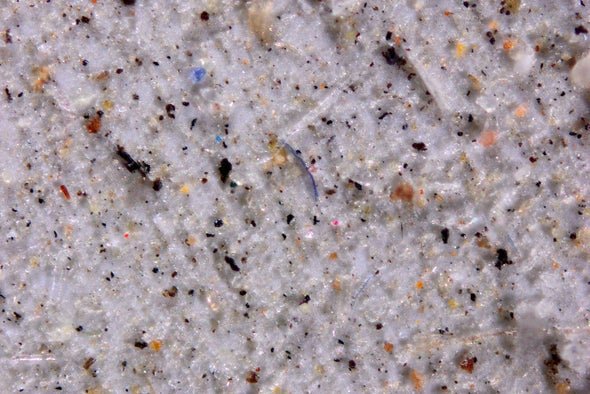microplastic
and how it found its way into our bodies
this website uses audio as an important part of its sonic experience, kindly consider turning it on
half of all plastic ever produced has been made in the last 15 years
The growth has been exponential since 1950. Over the past 20 years, people have become more and more mindful of the problem of plastic consumption and pollution.
Why is there no change?
floating islands of plastic trash are no longer only a marine or aesthetic problem
plastic isn’t biodegradable. instead, it breaks down in fragments

Microfiber image by @maxliboiron from publiclab.org licensed by Creative Commons Attribution-ShareAlike 3.0 Unported License
Every day billions of micro (~ red blood cell size) and nano (~ DNA size) plastic particles are released into the environment by exposure to ultraviolet light. Compared to the islands of floating trash in the ocean, these particles are not seen by the human eye, but that doesn’t mean that they don’t affect us.
the extremely small size of plastic particles makes them easily transmissible in the Earth’s atmosphere
What’s the big deal?
we’ve started looking, and microplastic IS everywhere:
arctic
atmosphere
Plastic fibers and beads in dusts collected from remote National Parks and Wilderness areas in the United States. Credit: Janice Brahney Utah State University
rain
oceans
Polyvinyl chloride fiber found in snow sample from Svalbard (a Norwegian archipelago between mainland Norway and the North Pole)
Very high concentrations indicate significant contamination in the atmosphere
with water, microplastics find their way into wildlife and our diet
-

marine life mistakes plastic for food
Photo: plastinography.org
-

bits of microplastic stay inside fish
Photo: microplastic found in fish / Marine National Park Operation Center Trang 3 / Facebook
-

small sized particles and fibers lead to contamination of tap and even bottled water

Photographs of microplastics identified by light microscopy in processed or packaged foods in different provinces of Ecuador: (a,b) refreshing; (c,d) craft and industrial beer; (e,f) skim milk; (g,h) artisanal and industrial honey. Diaz-Basantes, M.F.; Conesa, J.A.; Fullana, A. Microplastics in Honey, Beer, Milk and Refreshments in Ecuador as Emerging Contaminants. Sustainability 2020, 12, 5514. https://doi.org/10.3390/su12145514

won’t microplastics just pass through my digestive system?
not so easy
We are talking about micro and nanoparticles less than 150µm in length that can easily transfer from the digestive system into the bloodstream. From there microplastics can find their way to the lungs, kidneys, liver, spleen.
They can cause inflammation in the kidneys.
Permanent exposure to plastics is believed to be a part of a rising decline in men's fertility as seen over the last 50 years.
Negative health impacts can be caused not only by the chemical compound itself but also by its form. This is similar to how asbestos causes inflammation in the body, which leads to the possibility of cancer.
Asbestos under the microscope
aren’t concerns over microplastics blown out of proportion and overestimated?
Why is it important to act NOW even though the World Health Organization still classifies microplastics pollution in the water as “a low health concern”?
It is estimated that by 2040 there will be 113% more plastic waste in the ocean. That’s 23-37 million metric tons per year.
Now ask yourself about the number of microplastics that this amount of waste will generate in 20 years if the current trend of consumption continues.
Humanity already has the experience of the past 30 years of talks about global warming and consequent climate change, which was debated a lot by the opposition until it arrived, unexpectedly.
do we want to fail as miserably as we are failing now to mitigate CO2 emissions worldwide?
•USA’s swift plan on changing the ignition industry to electric cars should be accompanied by a similar reform in plastic production. The problem of growing emissions and excessive plastic production are interrelated. Just 20 companies are responsible for more than a half of single-use plastic items thrown away globally
•even though plastic awareness has a strong presence in the minds of Americans the problem of microplastics is still dangerously underestimated and should be addressed before serious health consequences for a population will follow
what can I do?
on a personal level
Recycle. You can find convenient locations using this resource
Stop the vicious consumption cycle of things you don’t need: clothes, gadgets, toys. You don’t need to throw away perfectly good things every season just because a new model entered the market
Stop using single-use plastic items that cannot be recycled - deli cups, plastic straws, bags, even single-use facemasks that are made of polymer. All these things can be easily replaced by more sustainable alternatives
on a macro level
Research, talk, share and finally vote on changing the local requirements for plastic regulation
Vote for a ban on single-use plastic items such as plastic cups, straws, bags, bottles
We have entered a transition period when the whole world is trying to shift from fuel. It is time to demand and vote for legislative change that will insist that the biggest polymer producers (Exxon Mobile, Dow) and their financial backers ( Barclays, HSBC, and Bank of America) start acting
But in order to change their production habits, the polymer producers should be given a nudge to do so, both in the form of subsidies and penalties. To do so requires a strong political will and in order for politicians to act in the interests of people, people should request this type of change. It won’t happen otherwise. Start from your local school, office, household. Then your city will follow and the state. This environmental activism will help in shaping new habits
Biodegradable plastic is not a myth. Although a lot of manufacturers don’t address the exact requirements to meet in order for plastic to be properly composted. This form of “greenwashing” should be called upon and penalized by the regulators
“microplastics” is an audio-visual project by Vladimir IlnitskiyThe ambient music that you hear consists of 2 piano notes playing together and getting transformed by a granular synth that fractures the sample into a thousand small pieces and plays them really fast. It is layered with a sample of crackling plastic sound effects, distorted with the same synth process, which should theoretically deliver a blatant message about plastic breaking down into fragments.
My goal is not to give you a lecture. I simply hope that some of the facts and news that are mentioned here will spark an interest and will make you more concerned about the future of the planet that we share. Don’t be afraid to act even if it seems that nobody cares. You are never alone.









